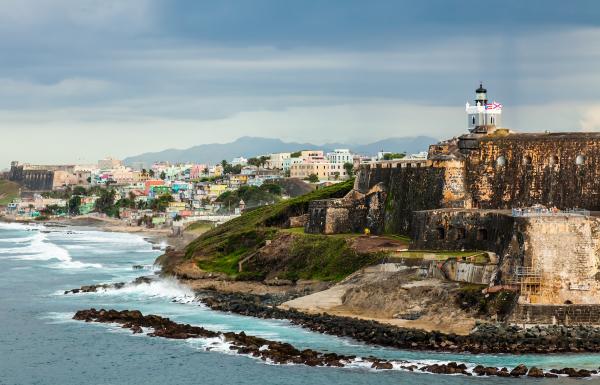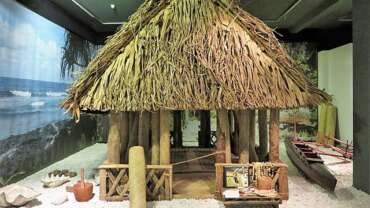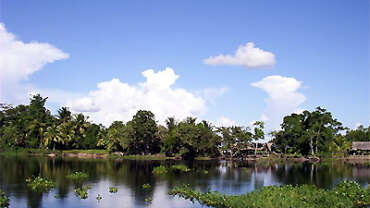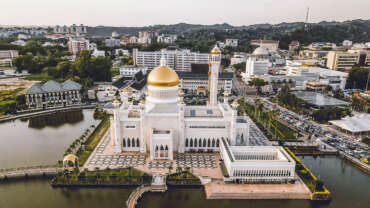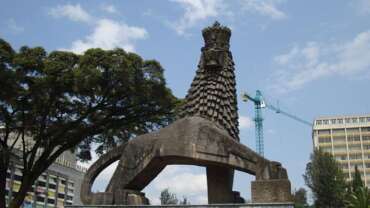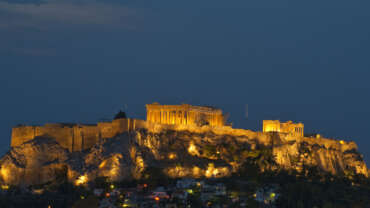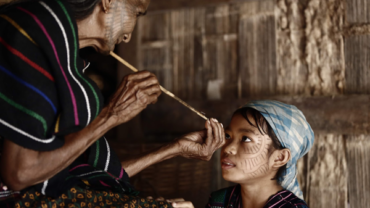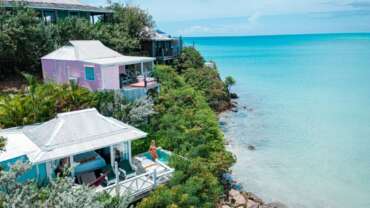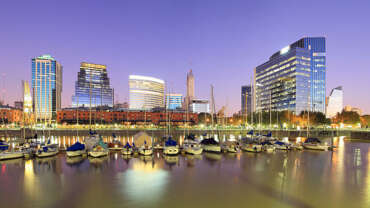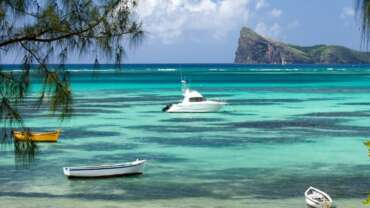Puerto Rico - The Heart & Soul of the Caribbean
Puerto Rico is a place where the Old World is mashed up with the new on an island that is small in size but offers an immense bounty of one-of-a-kind experiences.
Rich history and culture, exceptional food, pristine beaches, majestic mountains, relaxation, adventure — all packed into one sun-kissed Caribbean paradise. La Isla del Encanto is full of people who are buena gente (which is boricua slang for kind and friendly) and welcoming. Here, you’ll feel like you are family instead of just a visitor. Around every corner, you’ll find a celebration of life, a vibrant cultural experience, food for the soul, and a captivating rhythm.
Dare to discover the many treasures of Puerto Rico. Get inspired and start planning your trip. Let us be the first to say, bienvenidos.
History of Puerto Rico
A Brief History of Puerto Rico
Puerto Rico’s vibrancy derives from more than 500 years of rich history and the subsequent blending of different cultures.
This fusion extends to almost every aspect of the Island’s identity. From the interweaving of the Taíno, African, and Spanish traditions emerged the Puerto Rican, a new identity composed of traits from all three groups.
You’ll get to explore Spanish colonial architecture and prominent centuries-old buildings, savory dishes and dance moves rooted in African heritage, and lingo that locals still use from the Taínos. Puerto Rico’s identity is the very definition of a well-blended melting pot.
The Island’s cultural identity is something you’ll experience in every sight, taste, and sound during your stay.
Taíno Beginnings
Puerto Rico’s first inhabitants were the Taínos, a group of indigenous people who lived on the island for hundreds of years before the Spanish arrival. Organized in small clans and villages led by caciques (chiefs), they survived by fishing, hunting, and basic agriculture. The Taínos were governed by Agüeybaná and called the island Borikén (Borinquen) – which means “Land of the Valiant and Noble Lord.”
The arrival of the Spaniards in 1493 marked the beginning of the Taíno extinction. Already at war with the Caribs, another indigenous group migrating to the Antilles, the Taínos began to lose territory, and under Spanish ruling, the original boricuas ceased to exist.
European Arrival
Christopher Columbus arrived in Puerto Rico in 1493 during his second voyage to the New World. Initially, Columbus christened the Island as San Juan Bautista (St. John the Baptist). Still, the name was soon changed to Puerto Rico, or “rich port,” when the Spaniards realized the impressive amount of gold found in its rivers. When the capital city was established, it took the name of San Juan.
Under Spanish governance, the Island developed an even more sophisticated agriculture system than what the Taínos had founded. Sugar cane, coffee, and tobacco were among the Island’s major exports. Due to the increasing demand for products and the decreasing number of local inhabitants to work the land, Spain brought African slaves to Puerto Rico.
Given its location and richness, Puerto Rico became an important military outpost for Spain and was attacked by the Dutch, French, and English in a series of failed attempts to conquer the Island. Forts and Castles like El Morro and San Cristóbal were originally built to protect the strategically significant Island. The impressive citadels were never defeated, and you can still visit them today.
Brief Puerto Rican Autonomy
In the late 1800s, the desire for independence from the Spanish crown boiled over in Puerto Rico. While the Spanish soldiers quickly suppressed the rebellion in San Juan, outbursts and uprisings erupted throughout the Island, which led the Spanish crown to grant autonomy to the government on the Island. This change opened trade channels with other European colonies and the United States.
Becoming a US Territory
The autonomous government granted by Spain didn’t last long. After the Spanish-American war ended in 1898, Puerto Rico and Guam were ceded to the United States as part of the terms of the Treaty of Paris, and Puerto Rico maintains its provincial status to this day.
With Puerto Rico’s colonial state came several changes – mainly in currency, government, and education – with civil rights and political status being decided by U.S Congress, a power it still holds more than a century later.
During the first three decades of its rule over Puerto Rico, the U.S. Congress approved a new Puerto Rican Constitution that made the Island an autonomous U.S. commonwealth while the islanders retained full American citizenship.
Even after becoming a U.S. territory, Puerto Ricans take pride in preserving much of the Island’s indigenous traditions. Many of them can be appreciated in visits to the National Historic Site in San Juan, where you’ll learn more about the history of the discovery of the Island; the Cruceta del Vigía, a giant cross built-in 1983 to recall the checkpoint that sat at the top of a hill in the town of Ponce and was used as a watch post by the Spaniards in 1801; and the Cabo Rojo lighthouse, a beautiful 1882 structure on the southwest of Puerto Rico that overlooks the whole nature reserve.
These are just a few of the many historical sites you’ll discover while traveling around the Island.
People of Puerto Rico
Even though Puerto Ricans don’t have a defined race, they are proud of their identity.
Boricuas are the result of a multicultural tradition that began more than 500 years ago when the Spaniards arrived on the Island, inhabited at the time by the Taínos — an indigenous group with a significant presence throughout the Caribbean.
African influences were added to the melting pot years later when Spaniards brought slaves to the Island to work sugar and coffee plantations.
The fusion of those three races leads to the modern-day Puerto Ricans — good people who welcome visitors as part of their extended family. Puerto Ricans tend to be friendly and cheerful people who move their hands a lot when they talk and express their emotions with intensity and passion.
When you pass by locals walking through the cobblestone streets of Old San Juan, they will greet you with a buenos días (good morning), even if they do not know you. And if they sit near you in a restaurant while you taste a mallorca (popular local pastry) and a coffee, they will say buen provecho (enjoy your meal), just for the sake of courtesy.
Puerto Rico has a population of around 3.6 million people, and more than five million additional boricuas are residing in the mainland United States. The official languages on the Island are Spanish and English, and most of the population identifies as Christian. Puerto Rican society is educated with a literacy level that exceeds 93%. It is also inclusive, with same-sex marriage laws and other statutes that protect common-law marriages’ rights.
Famous Puerto Ricans
It is said that there are Puerto Ricans all over the world, and in part, it is because many have excelled in various disciplines such as film, music, and sports, elevating the reputation of the Island of Enchantment globally. For example, movie stars such as Rita Moreno, Raúl Juliá, Benicio del Toro, and Luis Guzmán are from Puerto Rico. Likewise, music icons such as Ricky Martin, Marc Anthony, Jennifer Lopez, and Daddy Yankee have Puerto Rican heritage.
In sports, Puerto Rico has giants such as baseball players Roberto Clemente, Iván Rodríguez, Roberto Alomar, Alex Cora, and Yadier Molina; boxers Félix “Tito” Trinidad, Héctor “Macho” Camacho, and Miguel Cotto; tennis player and Olympic gold medalist Mónica Puig; hurdler Javier Culson; and many others. In science, NASA geologist and astronaut Joseph M. Acaba, who has traveled to the International Space Station, was born to Puerto Rican parents.
The Island also has representation in other fields. Of Puerto Rican descent, Sonia Sotomayor was the first Latina to become a Supreme Court Justice. Dr. Antonia Coello became the first Puerto Rican and Hispanic person to be appointed as Surgeon General of the United States.
Cultural Life of Puerto Rico
Cultural Life
The idealized folk hero of Puerto Rico is the jíbaro, a rustic independent hill-farmer whose status in local song and story is similar to that of the gaucho of Argentina. However, modern Puerto Rican cultural life is a blend of North American and Latin, African, and Caribbean forms, as is evident in much of the island’s dance, music, art, literature, and sports. The pre-Columbian Taino culture, which was largely decimated by European colonizers, has had only limited impact on Puerto Rican life and is evident mainly in the use of certain linguistic expressions and words incorporated into the Spanish language, such as hamaca (“hammock”), cacique (“chief”), and tabaco (“tobacco”). African influences are found in food, music, and art. Music festivals, museums in Ponce and San Juan, and theatrical performances encourage hispanidad, or Spanish customs. Puerto Ricans have worked to preserve a Latin heritage while welcoming U.S. economic and social novelties, engendering a cultural dilemma that has often catalyzed political debate.
Daily life
Puerto Rican lifestyles have changed rapidly as new technologies, economic opportunities, and patterns of development emerged. The island as a whole remains far poorer than the United States, but its growing middle class has adopted living standards that would be familiar to most North Americans. Some two-thirds of Puerto Rican families own their own homes. Large expanses of former farmland have been converted to suburban communities (urbanizaciones), rural wooden shacks have been replaced by sturdy cement houses equipped with modern appliances, and cars have increasingly clogged modern highways, particularly during evening rush hours in the San Juan area. A voracious appetite for consumer goods, coupled with easy access to credit, prompts shoppers to jam air-conditioned suburban malls that feature U.S. chain stores, fast-food restaurants, and multiplex cinemas. On most Saturday nights in San Juan, well-dressed young suburbanites crowd the dance floors of nightclubs and hotels (once the exclusive province of tourists) or frequent the bars and cafés of historic Old San Juan.
Puerto Ricans continue to prefer traditional dishes with rice and beans, plantains, and beef, chicken, or pork. However, North American fast-food restaurants that sell hamburgers, pizza, and other fare are growing in popularity, particularly among the young. Traditional Creole foods include sopa de arroz con pollo (chicken-and-rice soup), sancocho (a beef-and-vegetable stew), tostones (fried plantain slices), flan, and casabe, powdery cakes made from ground cassava, often served with molasses and coconut milk. Local supermarkets are well stocked with traditional fare as well as frozen and processed foods, which are mainly imported from the United States. Locally produced soft drinks and rums are also popular.
Cultural institutions
Most of Puerto Rico’s cultural institutions, including its major universities and libraries, are concentrated in the San Juan area. The Puerto Rican Athenium (Ateneo Puertorriqueño; 1876) is a prestigious learned society. The University of Puerto Rico Library System (1903) is the island’s main library, with more than four million holdings divided among 12 sites. Works by Puerto Rican painters and sculptors are displayed in the Museum of Contemporary Art (1984) and the Puerto Rican Museum of Art (2000), which are in San Juan. Also notable are the Ponce Art Museum (1959) and the Museum of Religious Art, the latter housed in a 17th-century church in San Germán. The Luis A. Ferré Fine Arts Centre (1981) in San Juan is the venue for many theatrical and musical events. Among the island’s research centres are the Institute of Puerto Rican Culture (1955) and the International Institute of Tropical Forestry (1939). The Arecibo Observatory (1963–2020), a radio telescope with a 1,000-foot (305-metre) diameter, was, for most of its life, the largest of its kind in the world. It collapsed in 2020.
Visual arts
Some of the island’s earliest inhabitants created polychrome ceramics, amulets, and stone carvings. About 1000 CE the Taino used granite, marble, and other types of stone to carve three-pointed figures with human and animal features; they also produced ceremonial stools, wooden rattles, petroglyphs surrounding their ball courts, and stone-carved ceremonial belts or collars. During Puerto Rico’s colonial period, African slaves formed multicoloured coconut-fibre masks for local festivals, a tradition that is still carried on. José de Rivafrecha y Campeche (1751–1809) was the island’s first major painter. The most notable 19th-century painters were Ramón Atiles y Pérez and Francisco Oller. More recent artists include Julio Rosado del Valle, Rafael Tufiño, Antonio Martorell, and Augusto Marín.
Sounds like Puerto Rico
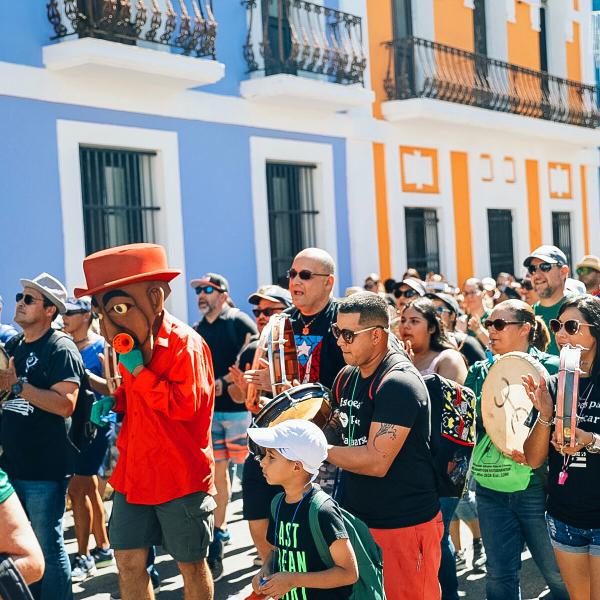
Go on a journey to understand our jargon and discover its origins.
Hear its essence, speak the lingo! “Sounds like Puerto Rico” wants to bring you closer to the Island’s culture, Taíno heritage, tropical vibes, and nature’s tranquility. You’ll learn about local common phrases and expressions, where they come from, and how to use them while exploring some of the Island’s vibrant spots.



